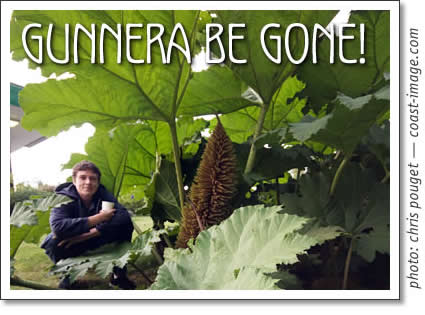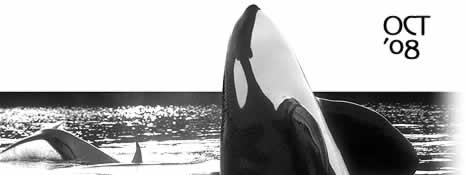
Gunnera be Gone! Goodbye old friend…
by Josie Osborne, Tofino

Without a doubt, the most commonly asked question by visitors to Tofino Botanical Gardens is "What is that plant that looks like giant rhubarb?" A few years ago, I would answer, "That's Gunnera, a South American plant that thrives in our mild wet climate here in Tofino. Do you want to buy one to take home?" Today, I answer, "That's Gunnera, a South American plant that we're very concerned about. In fact, we're removing all the Gunnera in the gardens this winter."
Almost anyone who's been to Tofino has seen this "charismatic megaphyte." You can't drive past the Tofino Co-op Gas Bar without noticing its huge leaves, fleshy stems and bizarre looking flowers. Gunnera probably does deserve the fascination we have with it. It's downright ugly. It's huge - in fact it may be the world's largest leafed herbaceous plant. And Gunnera is a truly ancient plant, having evolved some 150 million years ago, around the time of the dinosaurs. Named after Norwegian botanist Johan Ernst Gunnerus (who, by the way, described the basking shark and gave it its scientific name, Squalus maximus), Gunnera possesses glands that contain a cyanobacterium, Nostoc, which fixes nitrogen for the plant, meaning that Gunnera can live in what most plants would consider poor conditions. (Indeed, we have never had to fertilize the Gunnera at Tofino Botanical Gardens.) In fact, Gunnera is the only flowering plant in the world that has a symbiotic relationship with a cyanobacterium (all other nitrogen-fixing plant relationships are with the eukaryotic so-called "true" bacteria rather than prokaryotic cyanobacteria), making the plant of intense interest to molecular botanists. Gunnera is also of interest to indigenous peoples of the Chilean and Peruvian Andes; they eat the tender young stalks and leaves of the plant, called 'nalgas' in Spanish.Gunnera is not only the English common name of this plant, but also its scientific name. Of the 40 to 50 species of Gunnera, all belong to the same genus and the same family, Gunneraceae. All species are native to the Southern Hemisphere: most to South America but several small leafed creeping species are native to New Zealand and Tasmania, a few others to Africa and Southeast Asia. In the late 1800s, two of the largest species of Gunnera were introduced into horticulture by Victorian plant hunters returning home from South America: Gunnera manicata (the largest leafed Gunnera, also called Giant rhubarb) and Gunnera tinctoria (a slightly smaller species called Chilean rhubarb). Such cross-continental horticultural introductions were common practice in the 1800s and early 1900s, often with no detrimental effects - or at least, no detrimental effects for several decades. This is a typical pattern of introduced exotic plants: they're no problem for decades, then suddenly the plant becomes invasive, proliferating due to three main factors: 1. natural genetic variability that over generations of reproduction produces plants better suited to local conditions, 2. lack of natural predators, and 3. local climate change in the direction of a plant species' preferred growing conditions.
Like the early years of introduced Scotch broom (brought to Vancouver Island in 1850) and English ivy, Giant rhubarb and Chilean rhubarb quietly existed in gardens around the world's temperate latitudes for decades. Even today, successfully growing Gunnera remains a coup for many North American gardeners (it is a more challenging plant to grow than broom or ivy). Many on-line horticultural discussion forums are filled with threads about where to find Gunnera for sale and how to cultivate it in your own garden. But we at Tofino Botanical Gardens hope to change this attitude, at least in Tofino. "Hey!" you say, "Gunnera has been our good friend in Tofino for decades! Why change that now?" Consider this tale of two Gunnera introductions...
Native to southern Chile, Gunnera tinctoria was first brought to Ireland in 1939 as an ornamental plant. Its popularity as a garden plant grew quickly, and the plant did well since it was growing in a climate similar to its southern hemisphere home. However, despite the similarities of climatic conditions, it was growing in a community of completely different plants without its natural competitors and predators. It began to spread, and now Gunnera tinctoria is found on western Ireland's coastal cliffs, waterways, roadsides, wet meadows and derelict gardens and fields. Propagating both by seed and by vegetative means, in early spring its leaves begin to grow and in just weeks can reach over 2 meters in height, shading all plants growing below its 2 meter wide leaves. Gunnera tinctoria is now a major threat to plant biodiversity in some areas of Ireland, because smaller plants cannot grow in the shadow created by the giant leaves.
To fight the spread of this plant, Ireland is now applying herbicides to get rid of it. Bad news indeed.The story is similar in New Zealand. There, Gunnera tinctoria is at an early stage of invasion, having begun to naturalize (naturally occur outside gardens) in the 1960s. It now occupies coastal bluffs, riparian zones, and disturbed sites, much like western Ireland. The New Zealand government is following the herbicide path too - but they have also initiated an extensive public education program to counter its popularity in home gardens, and recently, they have taken their eradication efforts even further: it is now illegal to knowingly display, cultivate or propagate the plant. (A botanically progressive government, New Zealand has also outlawed logging in old-growth forests.)
So, what are those climatic conditions in Chile and Ireland that are so similar to the native South American homelands of Gunnera tinctoria? High annual rainfall and winter temperatures rarely falling below zero. Sound familiar? "But," you say, "In Tofino, the most commonly encountered species of Gunnera is the Giant rhubarb Gunnera manicata, not the invasive Chilean rhubarb Gunnera tinctoria. So, it's not a problem, right?" Think again. In a 1988 nationwide plant survey in New Zealand, botanists did not find Gunnera manicata; it had not (yet) naturalized. Phew. But in 1999, G. manicata seedlings were found in one area. Then in 2003, they were found in another location. G. manicata is following the exact same pattern of establishment in New Zealand that G. tinctoria did in the 1960s. Botanists in New Zealand are now recommending that all exotic large-leafed species of Gunnera be included in the ban on cultivation and propagation.Still not convinced? How about some evidence closer to home? In 1998, four Gunnera manicata and four Gunnera tinctoria plants were planted at the Tofino Botanical Gardens. Two years later, we took an offset of one of the G. manicata plants and placed it up near the Hippie Bus. In 2006, we noticed that several G. manicata plants had sprung up in two or three locations - hundreds of meters from the parent plants - and in 2007, a few more were found alongside the driveway. What's the big deal, it's just a few more plants! But consider this: in 2005, we planted four G. manicata offsets between our newly built home and the highway to create some screening. In early September (2008), I removed approximately 250 seedlings from about 30 square meters of our boggy lawn beside the house. That's right - 250 seedlings (ranging from 5 cm to 45 cm). I don't think they were there in 2006 or 2007. Something this year was just right for the Giant rhubarbs, and I'm now convinced that it's time to say goodbye to our old friend Gunnera. It was an unfortunate, but thankfully not irreversible, decision to plant Gunnera in the garden.
A final few words. Almost every gardening magazine in published in temperate countries has extolled the virtues of Gunnera. In 1993, the Royal Horticultural Society (the creme de la creme of gardening societies) gave Gunnera manicata an "Award of Garden Merit." If you Google "Gunnera" you will wade through pages of horticultural references, scientific references about Nostoc symbiosis, garden nursery ads, and postings from people avidly seeking sources of Gunnera - all before finding any information about the problems it has created in Ireland and New Zealand. Its exotic appeal, long horticultural history, and little-known invasive status in Ireland and New Zealand will likely make it difficult to convince people to remove it from their gardens. But - here in Tofino we have a chance now to remove this plant before leaving our children and grandchildren with the Scotch broom and English ivy legacy our grandparents left us.
Josie Osborne is a marine biologist and naturalist turned Gunnera-exterminator. She works for the Tofino Botanical Gardens and the Raincoast Education Society. You can reach her at 250.725.1220 or josie@tbgf.org to ask her questions about Gunnera (which is best removed by digging up the entire plant - roots and all - and letting the leaves compost or rot, but throwing away the roots and flower heads in the garbage).
tofino | tofino time | activities | accommodation | events | directory
maps | travel | food | art & artists | photos | horoscope | tides
search | magazine | issues | articles | advertising | contact us
hosted in tofino by tofino.net & studio tofino
© 2002-2014 copyright Tofino Time Magazine in Tofino Canada

Tofino biologist Jose Osborne writes about the eradication of gunnera manicata at the Tofino Botanical Gardens.
